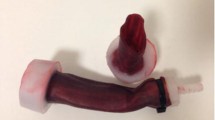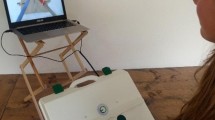Abstract
The aim of this study is to assess the difficulty of intracorporeal suturing in single-port surgery, using experimental suturing model in dry box. Subjects were divided for three groups: seven experienced laparoscopic surgeons, seven surgical residents, and seven interns. An experimental suturing model is developed, and working angle was set from 0° to 90°. The completion rate in 0° was significantly lower than that in the other angles. Completion rate of group A was higher than that of the other groups. Precision of task in group A was significantly higher than that of group B and group C in 0° and 60°. Stress score in 0° were significantly higher than that in the other angles. Our study demonstrated that intracorporeal suturing in single-port surgery seems to be more difficult than conventional laparoscopic surgery. Our data should be taken the institution under consideration for introduction of single-port surgery.




Similar content being viewed by others
References
Navarra G, Pozza E, Occhionorelli S, Carcoforo P, Donini I (1997) One-wound laparoscopi cholecystectomy. Br J Surg 84:695
Galvani CA, Gallo AS, Gorodner MV (2012) Single-incision and dual-incision laparoscopic adjustable gastric band: evaluation of initial experience. Surg Obes 8(2):194–200
Philipp SR, Miedema BW, Thaler K (2009) Single-incision laparoscopic cholecystectomy using conventional instrumenets:early experience in comparison with the gold standard. J Am Coll Surg 209:632–637
Tang B, Hou S, Cuschieri SA (2012) Ergonomics of and technologies for single-port lapaxroscopic surgery. Minim Invasive Ther Allied Technol 21(1):46–54
Champion JK, Hunter J, Trus T, Laycock W (1996) Teaching basic video skills as an aid in laparoscopic suturing. Surg Endosc 10:23–25
Aggarwal R, Hance J, Undre S, Ratnasothy J, Moorthy K, Chang A et al (2006) Training junior operative residents in laparoscopic suturing skills is feasible and efficacious. Surgery 139:729–734
Nguyen NT, Mayer KL, Bold RJ, Larson M, Foster S, Ho HS et al (2000) Laparoscopic suturing evaluation among surgical residents. J Surg Res 93:133–136
Cuschieri A, Francis N, Crosby J, Hanna GB (2001) What do master surgeons think of surgical competence and revalidation? Am J Surg 182:110–116
Yamaguchi S, Yoshida D, Kenmotsu H, Yasunaga T, Konishi K, Ieiri S et al (2011) Objective assessment of laparoscopic suturing skills using a motion-tracking system. Surg Endosc 25:771–775
Santos BF, Enter D, Soper NJ, Hungness ES (2011) Single-incision laparoscopic surgery (SILSTM) versus standard laparoscopic surgery: a comparison of performance using a surgical simulator. Surg Endosc 25:483–490
Yang B, Xu B, Zeng Q, Altunrende F, Wang H, Xiao L et al (2011) A specialized course of basic skills training for single-port laparoscopic surgery. Surgery 149:766–775
Santos BF, Reif TJ, Soper NJ, Hungness ES (2011) Effective of training and instrument type on performance in single-incision laparoscopy: results of a randomized comparison using a surgical simulator. Surg Endosc 25:3798–3804
Uchida K, Haruta N, Okajima M, Matsuda D, Yamamoto M (2005) Multimedia article, the keys to the new laparoscopic world Thumbs up! Knot and Tornado Knot. Surg Endosc 19(6):859
Acknowledgments
The authors thank Karl Storz for providing the laparoscopy during the study. Furthermore, we acknowledge the surgeons and resident surgeons and interns who performed the task in this study. This study was presented during SAGES in San Diego, March 2011.
Author information
Authors and Affiliations
Corresponding author
Ethics declarations
Conflict of Interest
Yasuhiro Ishiyama, Noriyuki Inaki, Hiroyuki Bando, and Tetsuji Yamada have no conflicts of interest or financial ties to disclose.
Rights and permissions
About this article
Cite this article
Ishiyama, Y., Inaki, N., Bando, H. et al. Assessment of Intracorporeal Suturing in Single-Port Surgery Using an Experimental Suturing Model. Indian J Surg 79, 137–142 (2017). https://doi.org/10.1007/s12262-016-1445-6
Received:
Accepted:
Published:
Issue Date:
DOI: https://doi.org/10.1007/s12262-016-1445-6




